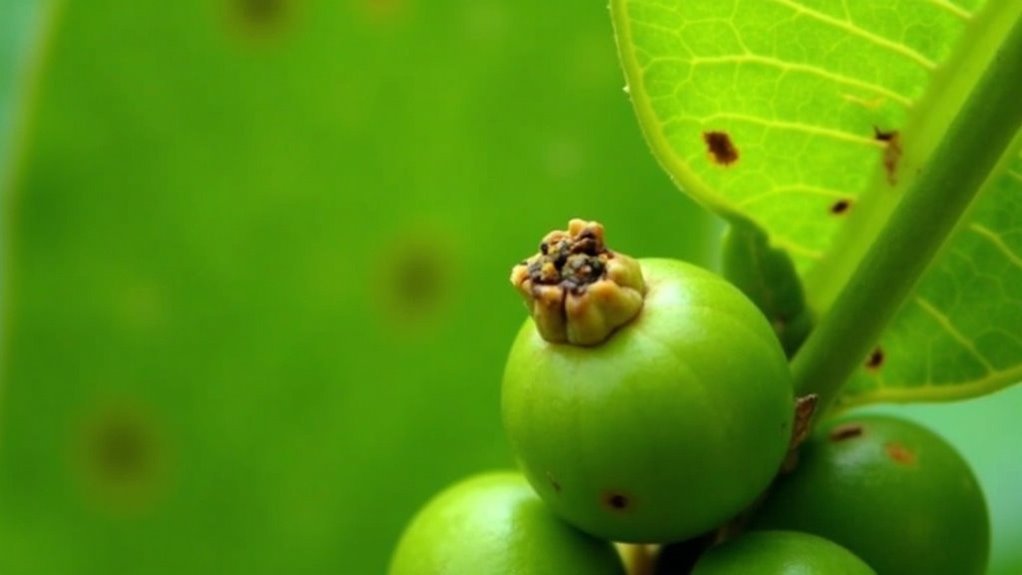Antestia bug damage in coffee can lead to significant yield reductions and quality decline, often resulting in losses of up to 38%. These pests feed on green coffee berries, causing symptoms such as zebra beans and increasing the berries’ susceptibility to fungal infections. Consequently, the overall health of your coffee crop deteriorates, negatively impacting its market value. Early detection is critical, as damage may only become visible during the drying stage. Understanding effective pest management strategies is vital for mitigating these effects and improving your coffee production.
Key Takeaways
Antestia bugs pose a serious threat to coffee crops, leading to average yield losses of approximately 30%, with potential losses reaching as high as 38%. The presence of zebra beans is a key symptom, indicating a decline in bean quality and a heightened risk of fungal infections. Unfortunately, damage often becomes apparent only during the drying stage of coffee processing, making early detection challenging. The feeding habits of antestia bugs create lateral holes in cherries and cause blackened flower buds, which adversely affect the overall health of the coffee crop. To effectively manage these pests, it is essential to implement strategies such as regular monitoring, pruning, and the application of organic insecticides when bug populations exceed established thresholds.
Understanding Antestia Bugs
Antestia bugs, notorious for their destruction in coffee cultivation, are shield-shaped insects that measure between 6 to 8 mm long. Their dark brown bodies, adorned with orange and white markings, allow them to blend into coffee plants, primarily hiding in berry or flower clusters.
Female antestia bugs lay about 12 eggs on leaf undersides, with nymphs emerging resembling adults in color but lacking wings and measuring only 1 mm. Both life stages feed on green coffee berries, causing significant damage and potential yield losses averaging 30%.
Effective management, including monitoring and pruning, is essential to mitigating their impact on coffee quality. This information is vital for coffee producers to protect their crops and ensure a successful harvest.
Life Cycle and Feeding Habits
Understanding the life cycle and feeding habits of coffee pests is essential for effective coffee management. Here’s how it unfolds:
- Female pests lay eggs in clusters of about 12 on the underside of coffee leaves.
- Newly hatched nymphs, about 1 mm long, resemble adults but lack wings and begin feeding on green coffee berries.
- Adult pests continue this feeding, severely damaging the developing berries.
- This feeding leads to reduced yield and quality, with losses averaging 30%, and even up to 38% depending on the infestation.
Being aware of these stages can greatly aid in controlling pest populations in coffee cultivation.
Symptoms of Antestia Bug Damage
When you observe zebra beans on your coffee plants, it signals a decline in bean quality and possible fungal infections.
The infested branches may also show signs of fan branching, indicating the stress on the plant.
Furthermore, the damage isn’t always apparent until the coffee cherries reach the drying beds, complicating early detection and potentially impacting your yield considerably.
Visual Indicators of Damage
Visual indicators of damage caused by the antestia bug can significantly affect coffee quality, presenting challenges during both cultivation and post-harvest processing.
Here are several key symptoms to look for:
- Lateral holes in coffee cherries, indicating feeding damage.
- Blackened flower buds, which signal reproductive failure.
- Fan branching on infested branches, a response to stress from the pest.
- Zebra beans, which may suggest poor quality and potential fungal issues.
These visual signs may often go unnoticed until the post-harvest stage, where affected beans can be found among the yield.
To effectively mitigate these damaging effects, it’s crucial to monitor the number of bugs per tree regularly.
Quality Degradation in Beans
Damage from antestia bugs leads to noticeable quality degradation in coffee beans, significantly affecting both marketability and consumer acceptance. Infested cherries may harbor these pests, resulting in the formation of lateral holes and the notorious zebra beans. These visual defects indicate poor quality, often resulting in rejection by buyers. Furthermore, post-pulping, beans may display color inconsistencies, which can lead to their disposal in order to maintain quality standards. The table below summarizes critical symptoms of antestia bug damage in coffee:
| Symptoms | Description |
|---|---|
| Zebra Beans | Visually defective beans |
| Lateral Holes | Feeding marks from antestia bugs |
| Potato Taste Defect | Off-flavor caused by the infestation |
| Color Defects | Inconsistent coloration after washing |
| Widespread Infestation | Up to 98.7% prevalence on Rwandan farms |
Impact on Coffee Yield
Although the presence of antestia bugs is often overlooked, their impact on coffee yield can be devastating, leading to significant losses in production.
You might notice:
- An average yield loss of 30%, with potential peaks of 38%.
- Zebra beans, which indicate poor quality and increased susceptibility to fungal infections.
- Fan branching in damaged branches, a direct result of insect feeding.
- Blackening of flower buds, which leads to a complete lack of fruit set.
These symptoms not only reduce your overall coffee production but also compromise the perception of quality.
Notably, the risk of potato taste defect (PTD) increases by 73% with each additional bug per tree.
Impact on Coffee Quality and Yield
When antestia bugs infest coffee trees, they can severely compromise both yield and quality. These pests can cause average yield losses of 30%, with potential peaks at 38%.
Their feeding behavior notably increases the risk of potato taste defect (PTD) by 73%, directly impacting the flavor profiles of coffee. Additionally, feeding by antestia bugs leads to the formation of zebra beans, which serve as indicators of poor quality and increased susceptibility to fungal infections.
In Rwanda, the presence of these bugs has driven coffee prices down by $2.00 per kilo, threatening farmer livelihoods and undermining the overall development of the coffee sector.
Detection and Identification of Damage
Detecting and identifying damage caused by antestia bugs is crucial for preserving the health of coffee crops. Here’s what to look for:
- Distinctive Shield Shape: Adult antestia bugs, which measure 6-8 mm, exhibit dark brown colors accented with vibrant orange and white markings.
- Egg Clusters: Female bugs deposit white eggs on the undersides of leaves, which turn black when infested.
- Lateral Holes: Feeding damage is evident through small holes in coffee cherries, which may indicate the presence of Potato Taste Defect.
- Color Defects: Beans affected by these pests may show discoloration when drying on beds, signaling the need for removal to avoid quality loss.
Regular monitoring is essential for effective pest management in coffee cultivation.
Control Measures for Antestia Bugs
Managing antestia bugs effectively is essential for protecting coffee crops and ensuring high-quality yields.
To implement control measures for these pests, regularly prune and desucker coffee trees to reduce dense foliage where the adult antestia bug, which is shield-shaped, can hide.
If populations exceed thresholds—such as more than three bugs per tree in Tanzania—spraying with Neem is advisable.
Additionally, encouraging naturally occurring parasitic wasps that target antestia bug eggs can aid in early detection of damage.
Monitoring for signs like lateral holes in cherries is crucial to prevent potato taste defect and maintain peak coffee quality.
Integrated Pest Management Strategies
To effectively combat antestia bugs and maintain the health of coffee crops, it’s crucial to integrate various pest management strategies.
Integrating diverse pest management strategies is essential for controlling antestia bugs and ensuring healthy coffee crops.
Consider these integrated pest management approaches specifically tailored for coffee cultivation:
- Regular Monitoring: Regularly inspect for bug populations, adhering to the established thresholds of 3 bugs per tree in Tanzania, 2 in drier regions of Kenya, and 1 in wetter areas to ensure timely intervention.
- Natural Insecticides: Employ organic solutions that target antestia bugs while minimizing the reliance on synthetic chemicals, fostering a healthier coffee ecosystem.
- Pruning: Conduct regular pruning to remove dense foliage, which not only deters pests but also improves air circulation and overall plant health.
- Wet Milling Techniques: Adopt wet milling methods such as floating and processing damaged beans to improve coffee quality and reduce defects, ensuring a premium product.
These integrated pest management strategies contribute to the overall health and productivity of coffee crops, ensuring high-quality yields.
Supporting Farmers in Affected Regions
While antestia bug damage significantly threatens coffee yields, supporting farmers in affected regions is crucial for maintaining both crop quality and economic viability.
Implementing integrated pest management techniques is essential; training farmers on scouting and controlling antestia bugs can substantially reduce yield losses, which average 30% and may reach 38%.
Accessibility to information about coffee quality issues is often limited, making education essential. Contracts with suppliers that address coffee quality concerns foster transparency and support.
Continuous investment in coffee production not only enhances earnings but also empowers farmers to focus on quality improvement and effective pest management.
For inquiries, please contact us at EMAIL ADDRESS.








